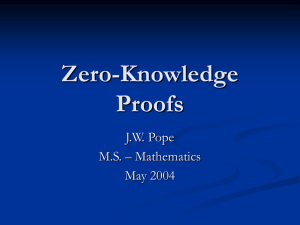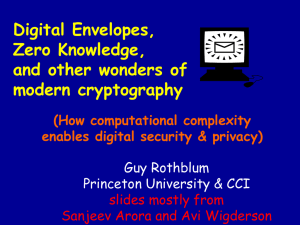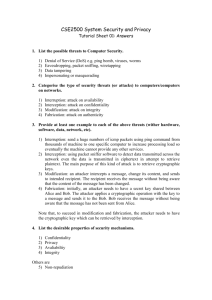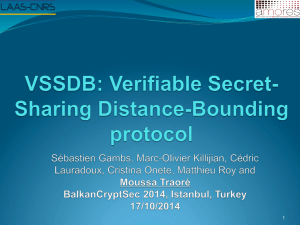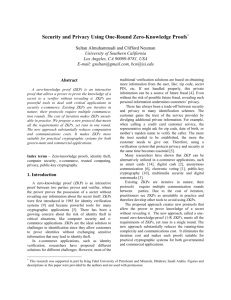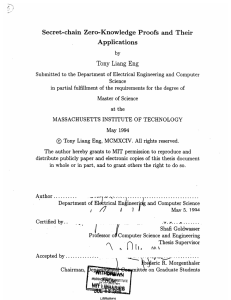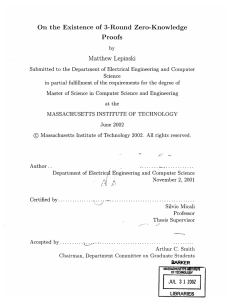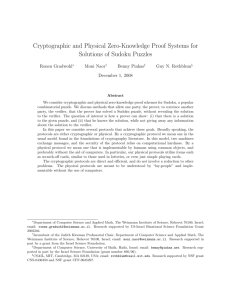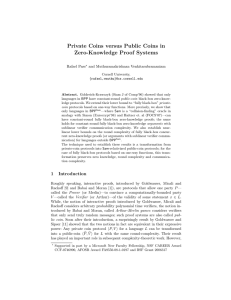Zero-Knowledge Proofs - Department of Computer Science
advertisement
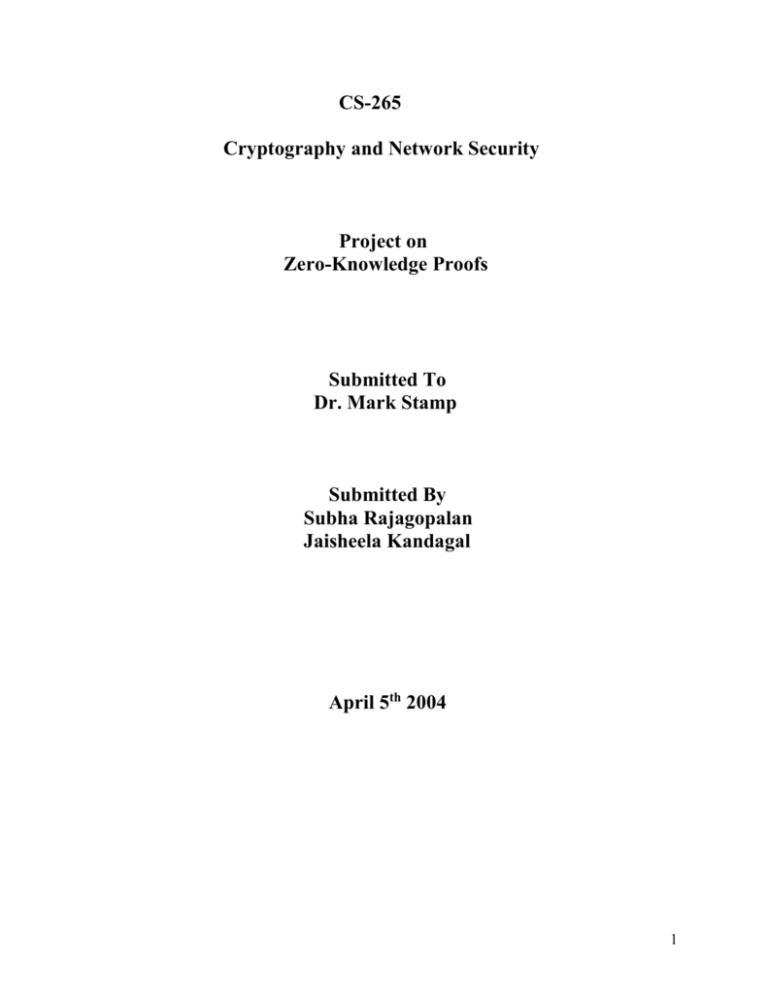
CS-265
Cryptography and Network Security
Project on
Zero-Knowledge Proofs
Submitted To
Dr. Mark Stamp
Submitted By
Subha Rajagopalan
Jaisheela Kandagal
April 5th 2004
1
Zero-Knowledge Proofs
Introduction
Goldwasser, Micali, and Rackoff first put forward the basic notion of Zero-Knowledge
Proof in 1985. Zero-Knowledge (ZK) protocol is an instance of interactive proof
protocol. An interactive proof protocol is one that authenticates a prover to a verifier
using challenge-response mechanism. In this kind, the verifier can accept or reject
the prover at the end of their communication.
The ZK protocol overcomes major concerns with widely used password based
authentication. In a simple password based authentication, the verifier authenticates
the prover based on a password. The verifier has some, if not complete, knowledge
of the prover’s password. The verifier can thus impersonate the prover to a third
party with whom the prover may share the same password. The main objective of
zero-knowledge protocol is to enable the prover convince the verifier that she knows
the secret without revealing any information about the secret itself. ZK protocols are
mostly probabilistic, where the proofs hold good with a very high probability of
success, and are not necessarily absolute. So, the verifier may either accept or
reject the proof after exchanging multiple messages. The messages consist of
challenges and responses. The probability of error can be reduced to a desirable
level by increasing the number of challenges and responses.
There are different variations of zero-knowledge protocols that exist. Some of them
are Perfect ZK, Resettable ZK, Concurrent ZK, Statistical ZK etc.
Properties of Zero-Knowledge Proofs
ZK protocols derive their properties from interactive proof protocols.
Completeness: The protocol is considered complete, if it succeeds with a very high
probability for an honest verifier and an honest prover. The acceptable level of
probability depends on the application.
Soundness: The protocol is considered sound, if it fails for any other false assertion,
given a dishonest prover and an honest verifier.
Advantages of Zero-knowledge proofs
Zero knowledge transfer – As the verifier does not learn anything about prover’s
secret s (no knowledge transferred between two parties), he cannot impersonate the
prover to a third person. Also the prover cannot cheat the verifier with several
iterations of the protocol.
2
Efficiency – The computational efficiency of ZK protocol is because of its interactive
proofs nature. The costly computation related to encryption is avoided.
Degradation – The security of protocol itself does not get degraded with continuous
use as no information about the secret is divulged.
Unsolved mathematical assumptions – ZK protocols are based on various
mathematical
Problems like discrete logarithms and integer factorization.
Fiat-Shamir Identification protocol
Fiat-Shamir identification protocol is an example of ZK protocol. In this protocol Alice
proves to Bob her knowledge of a secret, s, using many rounds of three message
challenge-responses.
Step1 - A random modulus, n, product of two large prime numbers p and q, is
generated by a Trusted Party. The trusted party keeps the primes p and q secret
and publishes n.
Step2 -Alice, the prover selects a secret s, relatively prime to n. Alice, then makes v
(=s2) public.
Step3 -To prove her knowledge of the secret s, Alice chooses a random number r,
(1 r n-1) using a random generator. She sends x = r2 mod n, to Bob, the verifier.
This is her commitment to authentication.
Step4 -Bob randomly sends either a 0 or a 1 as e, his challenge.
Step5 -Alice computes the response y = r se mod n, where e {0,1} is the challenge
she receives from Bob. Thus, depending on Bob’s challenge, 0 or 1, Alice responds
with r or, r.se mod n.
Step6 -Bob accepts the response upon checking y2 x * ve mod n, and rejects if y =
0.
Steps 3-6 are repeated every time Alice wants to prove her knowledge of the secret,
symbolically represented in Fig- 1.
A B: x = r2 mod n
A B: e {0,1}
A B: y = r * se mod n
Fig – 1 Fiat-Shamir Zero-knowledge protocol
3
After several iterations, with a very high probability Bob can verify Alice’s
identification. Also Alice’s response in either case does not reveal the secret s (with
y = r or y = r* s mod n).
Since the prover is required to commit a value (the random number r) before the
verifier sends a challenge, the probability that a dishonest impersonator can
authenticate as Alice is only ½. Repeating the above steps several times decreases
the probability that an impersonator without knowledge of the secret can get the
correct response.
It is important that Alice does not repeat the random number r. Bob can collect a set
of Alice’s responses and learn about the secret s, with repeated r. Later Bob can
impersonate Alice to a third person.
Classic Example of Zero-Knowledge Proofs
Ali Baba’s cave
Lets consider an example of Ali Baba’s Cave. Alice wants to prove to Bob her
knowledge of the secret to open the door R-S in the cave without revealing the
secret.
Fig 2. Representation of Ali Baba’s Cave
(Source: http://www.rsasecurity.com/rsalabs/faq/2-1-8.html)
They work as follows:
Alice enters the tunnel and takes the path either R or S. Bob is not aware of this,
standing outside the tunnel (P). Bob comes to Q and calls out Alice through either R
or S. The probability that Alice comes out through the right tunnel is only ½ , if she
does not know the secret. So bob can repeat this several times until he is convinced
that Alice knows the secret to open the door. In this process, Bob doesn’t learn the
secret.
Real-Time Applications of Zero-Knowledge Proofs
ZK protocols are used for many real-time applications like authentication, e-voting,
watermark verification, etc. Some products like Sky’s VideoCrypt, Microsoft’s
NGSCB also use ZK protocols. Here, a few of them are mentioned.
4
Watermark verification
For watermarking schemes, it is very important to show the presence of watermark
in the image without actually revealing it .This prevents any malicious user from
removing the watermark and reselling multiple copies of duplicate watermark.
Kinoshita Hirotsugu uses zero knowledge interactive proofs based on Digital
Signatures to assert ownership on an image.
Sky’s VideoCrypt
Sky’s VideoCryt is an analogue decoding card for satellite Directv descrambler used
to authenticate the subscriber’s card. This uses Fiat-Shamir Zero Knowledge
Protocol. The subscriber center holds the public key, secret key and the address
while the card holds the public key and address. Every few seconds, the center
requests all the cards to authenticate themselves. Each card which is valid has the
algorithm for some function F(x) in its ROM while the data for F(x) is in EEPROM. As
described earlier in Fiat-Shamir protocol, virtually no knowledge is transferred
between F(x) and EEPROM.
NGSCB
Next Generation Secure Computing Base (NGSCB) is Microsoft’s proposed secure
computing environment to use zero knowledge proofing techniques to verify
authenticity of services and code.This authentication is called Attestation which
uses third party for signature verification.By this way, anonymity of the service is
preserved.
References
[1] A basic intro to VideoCrypt, “http://www.heyrick.co.uk/willow/vcrypt.html”
[2] Alfred J. Menezes, Paul C. van Oorschot, Scott A. Vanstone, “Handbook of
Applied Cryptography”
[3] A Mitropoulos, and H. Meijer, “ Zero-knowledge proofs – a survey”
[4] A Trusted Open Platform,
“ http://www.cs.cornell.edu/People/egs/syslunch- spring04/palladium.pdf”
[5] Don Coppersmith (Ed.), “Advances in Cryptology- CRYPTO ’95 Lecture Notes in
Computer Science”
[6] Gaurav Gain, “ Zero-knowledge proofs: A Survey”
[7] H Aronsson, “ Zero-knowledge protocols and small systems”
5
[8] Hirotsugu Kinoshita, Terunobu Kobayashi , “An Online Verification Watermark
System with Zero Knowledge Interactive Proof for the Graph Isomorphism”,
http://www.ipsj.or.jp/members//Journal/Eng/4205/article023.html
[9] J. -J. Quisquater, L. Gullou, and T Berson, “How to explain zero-knowledge
protocols to a children”
[10] K. Gopalakrishnan, and Nasir Memon, “Protocols for watermark Verification”
www.cs.ecu.edu/~gopal/water.ps
[11] Mark Stamp, “NGSCB”
http://www.cs.sjsu.edu/faculty/stamp/CS165/my_ppt/4b_NGSCB.ppt
[12] Oded Goldreich, Silvio Micali and Avi Wigderson, “ Proofs that yield nothing but
their validity and a methodology of cryptographic protocol design”.
[13] Oren, Y., “ Properties of Zero-knowledge Proofs”.
[14] Ross Anderson, Security Engineering
[15] Wenbo Mao, Modern Cryptography theory and practice
[16] www.rsa.com
[17] www.wisdom.weizmann.ac.il/~oded/papers.html
6
